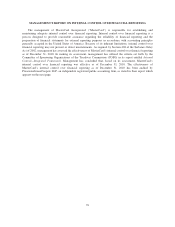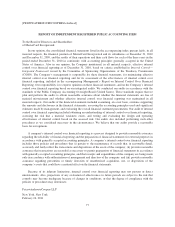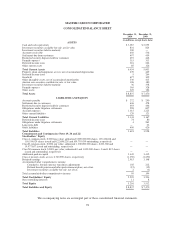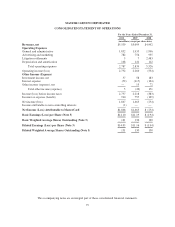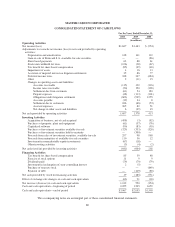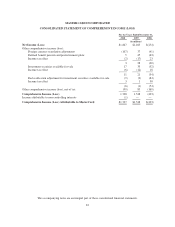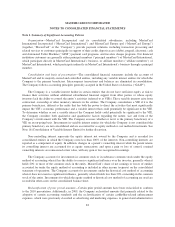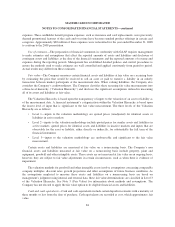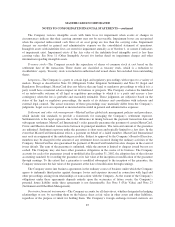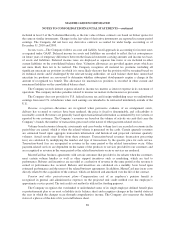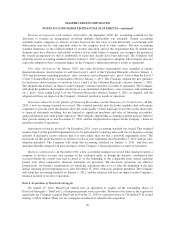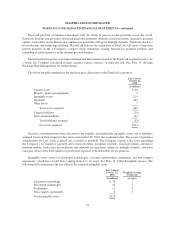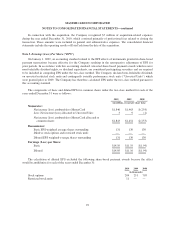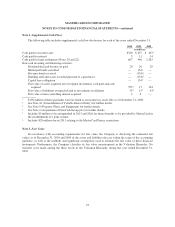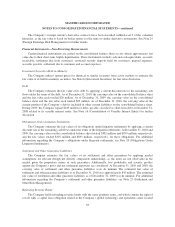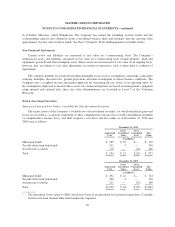MasterCard 2010 Annual Report Download - page 96
Download and view the complete annual report
Please find page 96 of the 2010 MasterCard annual report below. You can navigate through the pages in the report by either clicking on the pages listed below, or by using the keyword search tool below to find specific information within the annual report.MASTERCARD INCORPORATED
NOTES TO CONSOLIDATED FINANCIAL STATEMENTS—continued
Restricted security deposits held for MasterCard International members—MasterCard requires and holds
cash deposits and certificates of deposit from certain members of MasterCard International as collateral for
settlement of their transactions. These assets are fully offset by corresponding liabilities included on the
consolidated balance sheet. However, the majority of collateral for settlement is typically in the form of standby
letters of credit and bank guarantees which are not recorded on the balance sheet.
Property, plant and equipment—Property, plant and equipment are stated at cost less accumulated
depreciation and amortization. Depreciation of equipment and furniture and fixtures is computed using the
straight-line method over the related estimated useful lives of the assets, generally ranging from two to five
years. Amortization of leasehold improvements is generally computed using the straight-line method over the
lesser of the estimated useful lives of the improvements or the terms of the related leases. Capital leases are
amortized using the straight-line method over the lives of the leases. Depreciation on buildings is calculated
using the straight-line method over an estimated useful life of 30 years. Amortization of leasehold improvements
and capital leases is included in depreciation expense.
The Company evaluates the recoverability of all long-lived assets whenever events or changes in
circumstances indicate that their carrying amount may not be recoverable. If the carrying value of the asset
cannot be recovered from estimated future cash flows, undiscounted and without interest, the fair value of the
asset is calculated using the present value of estimated net future cash flows. If the carrying amount of the asset
exceeds its fair value, an impairment is recorded.
Leases—The Company enters into operating and capital leases for the use of premises, software and
equipment. Rent expense related to lease agreements which contain lease incentives is recorded on a straight-line
basis.
Business combinations—The Company accounts for businesses acquired in business combinations under the
acquisition method of accounting. The Company measures the tangible and intangible identifiable assets
acquired, liabilities assumed, and any noncontrolling interest in the acquiree at the acquisition date, at their fair
values as of that date. Acquisition-related costs are expensed separately from the business combination and are
included in general and administrative expenses. Any excess of purchase price over the fair value of net assets
acquired, including identifiable intangible assets, is recorded as goodwill.
Goodwill—Goodwill represents the excess of cost over net assets acquired in connection with the
acquisition of businesses accounted for as business combinations. The Company tests its goodwill for
impairment annually as of October 1, or sooner if indicators of impairment exist. The impairment evaluation
utilizes a two step approach. The first step is to determine if the carrying value of the reporting unit including its
goodwill exceeds its fair value. If so, the second step measures the amount of the impairment loss. Impairment
charges, if any, are recorded in general and administrative expenses on the consolidated statement of operations.
See Note 10 (Goodwill) for additional information on the Company’s goodwill.
Intangible assets—Intangible assets consist of capitalized software costs, trademarks, tradenames, customer
relationships and other intangible assets, which have finite lives, and customer relationships related to the
acquisition of Europay International S.A. in 2002, which have indefinite lives. Intangible assets with finite useful
lives are amortized over their estimated useful lives, which range from 1 to 10 years, under the straight-line
method. For capitalized software, MasterCard capitalizes average internal costs incurred for payroll and payroll
related expenses by department for the employees who directly devote time to the design, development and
testing phases of each capitalized software project.
86


